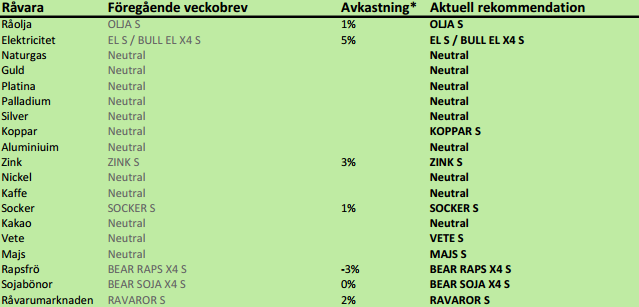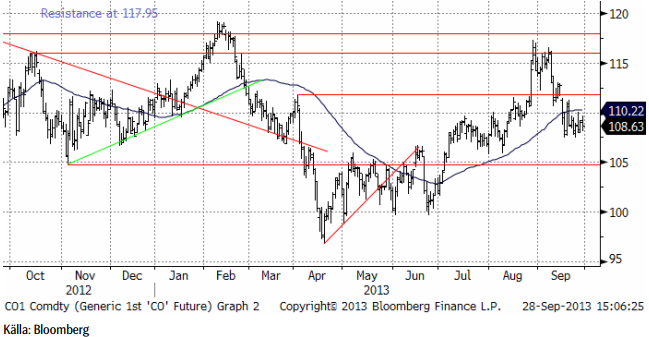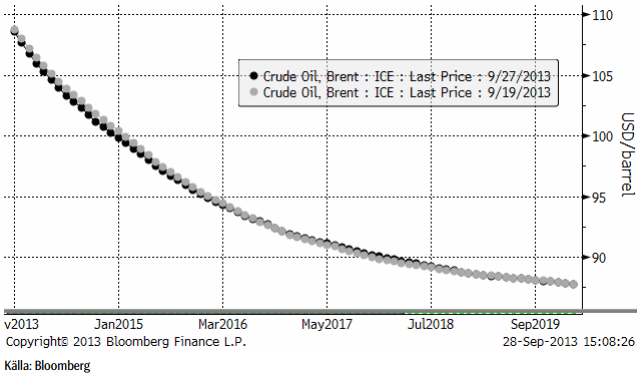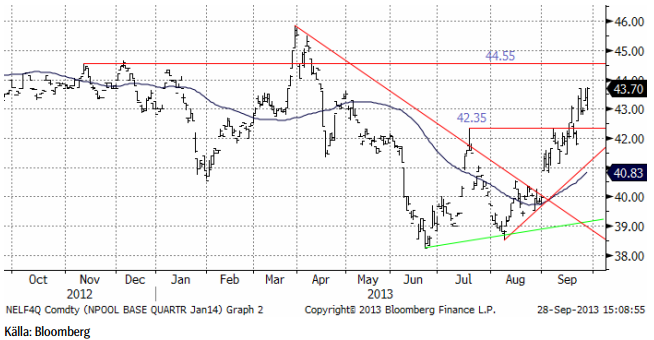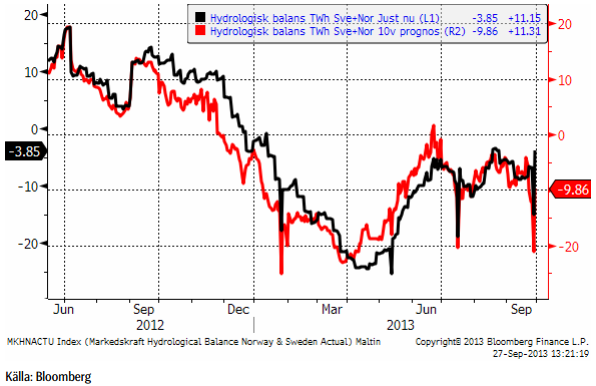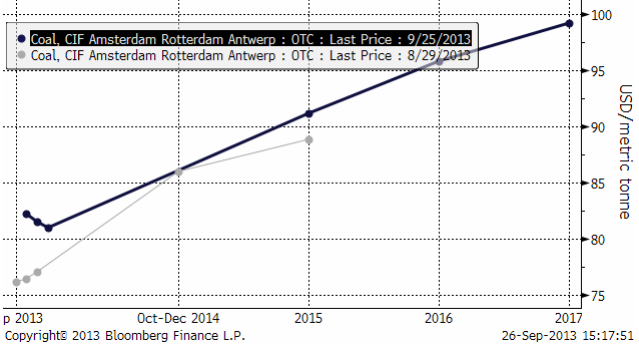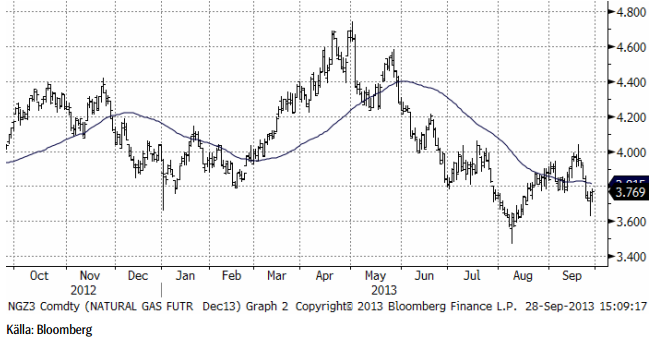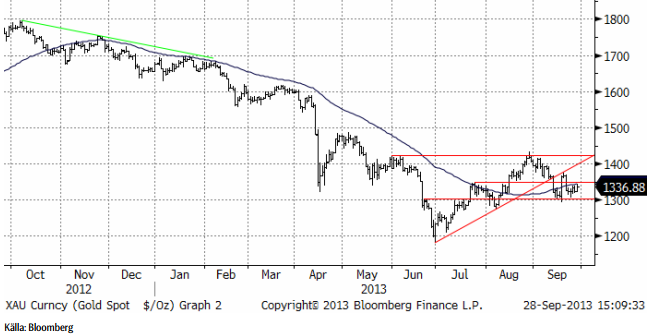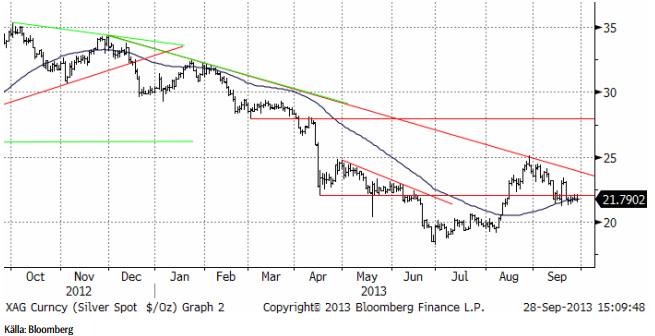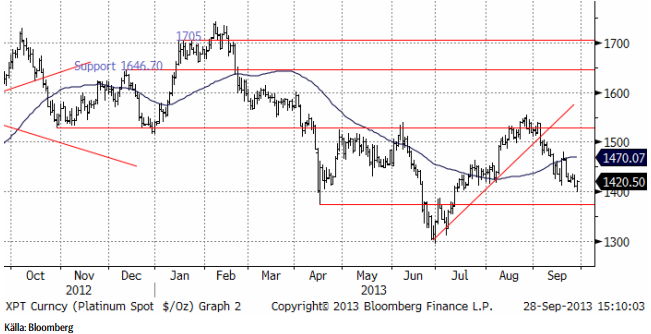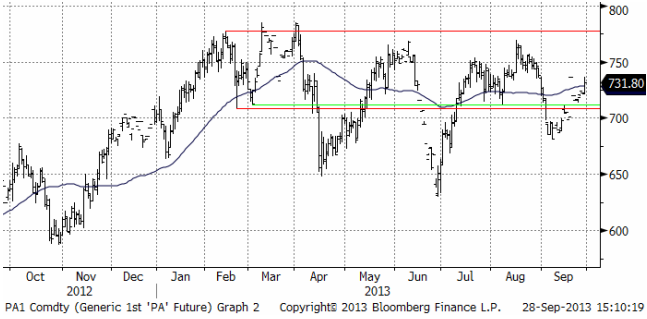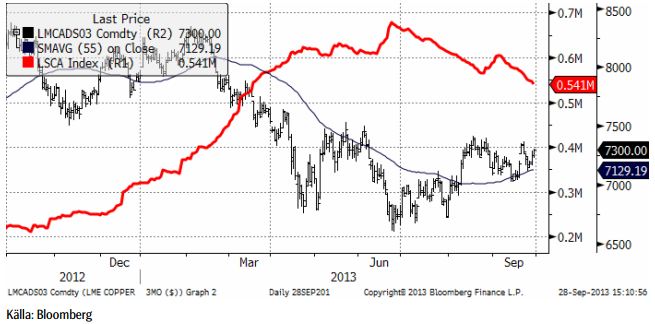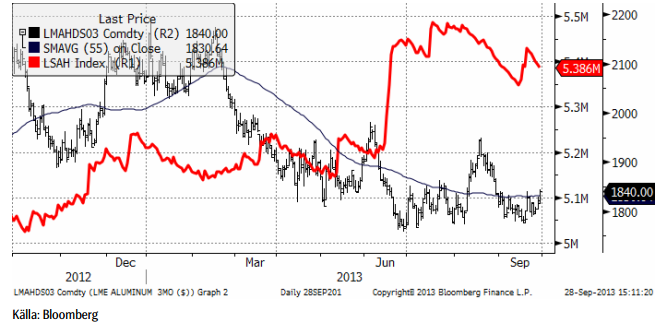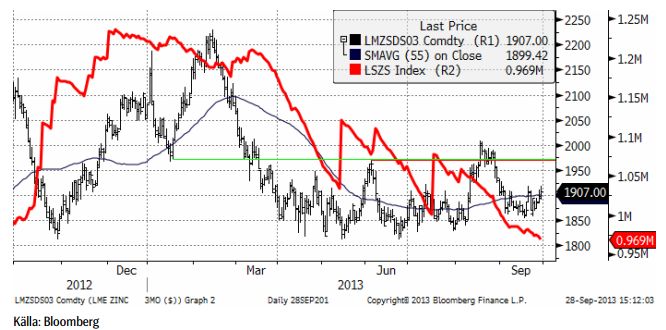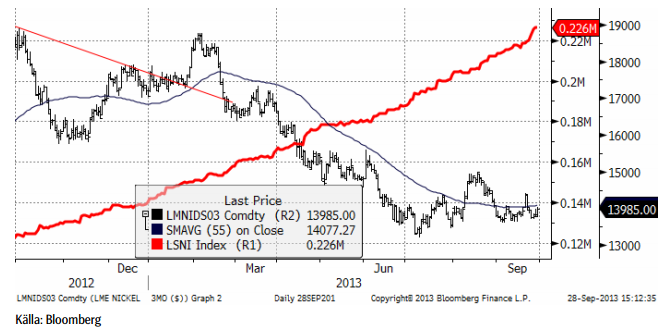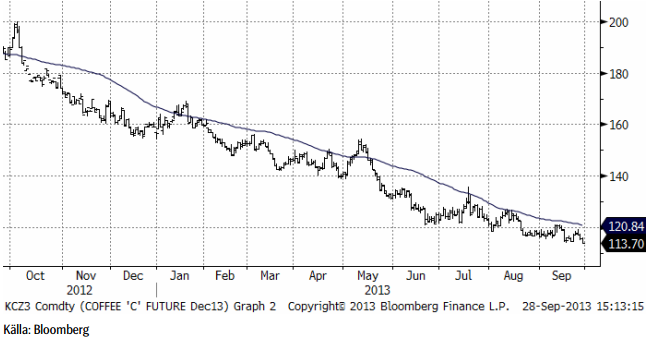Analys
SEB – Råvarukommentarer, 30 september 2013

Rekommendationer
*) Avkastningen anges för 1:1 certifikaten där både BULL och 1:1 certifikat är angivna.
Inledning
Elpriset har fortsatt att stiga och BULL EL X4 S belönade dem som köpt med 17% ytterligare avkastning. Den har stigit med 35% den senaste månaden. Ett högre elpris är fortsatt vår främsta rekommendation. Rekyler ska betraktas som köptillfällen.
Vi anser att vi har tidiga tecken på en vändning uppåt i pristrenden för vete och majs. Därför byter vi rekommendation från neutral till köp på dessa. För oljeväxter har vi fortfarande säljrekommendation. Den tekniska analysen av sojamarknaden indikerar ett nytt stort prisfall från fredagens 1319 till 1250 cent per bushel.
Den sista september är det dags att ta emot lagerstatistiken från USDA: hur stora lagren av spannmål och oljeväxter som fanns i USA den 1 september.
Estimaten hos marknaden är som följer:
Statistiken publiceras klockan 18:00 svensk tid.
Vi går också över till köprekommendation på koppar och certfikatet KOPPAR S.
Det är den så kallade Golden Week i Kina den här veckan, vilket innebär att affärslivet går på sparlåga där hela veckan
Råolja – Brent
Oljepriset backade med 1% förra veckan. Vi tror det finns risk för ytterligare svaghet i prisutvecklingen.
Terminskurvan för Brent ligger något lägre än förra veckan. Det som annars är så påfallande är rabatten på terminerna i förhållande till spotpriset.
När nu priset fallit tillbaka och rabatten på terminer är så attraktiv, tycker vi att det är ett bra tillfälle att komma in i den lönsamma oljemarknaden och rekommenderar köp av OLJA S. Det är framförallt rabatten på terminerna vi vill komma åt och därför föredrar vi OLJA S framför t ex BULL OLJA X4 S.
Elektricitet
Elpriset har fortsatt upp, vilket har fört med sig att vår rekommendation av EL S gett 5% den senaste veckan och BULL EL X4 S har gett 17% i avkastning. Vi ser att vi närmar oss ett tekniskt motstånd på 44.55 euro per MWh. Trots vad vi skriver nedan, tror vi det kan finnas anledning att tro att det kan komma en rekyl nedåt. Detta är ett utmärkt tillfälle att komma in i marknaden på. Den här haussen drivs av långsiktiga förändringar i marknaden för kol och energi, som varit fallande i tre år och nu vänt upp igen.
Markedskraft har under hela uppgången haft en säljrekommendation till sina kunder. Och man kan inte heller se någon anledning för dem att tro på en prisuppgång när man ser på deras prognos för hydrologisk balans, som vi ser nedan.
Vi har, som bekant fokuserat på det nedtryckta priset på kol och på att en normalisering av den marknaden har inletts. Ser vi däremot till väderleksprognoser har de inte gett mycket att hålla i. SMHI:s modeller har fladdrat fram och tillbaka mellan blött och torrt den senaste tiden. Den senaste prognosen från i fredags visar på blötare väder. Samtidigt skriver de att det troligaste är ”nog” att det fortsätter som förut. Vi väljer att inte tro på modellerna, utan på vad meteorologerna skriver, alltså håller vi fast vid något torrare väder.
Vad som stödjer detta är beteendet hos den Nordatlantiska Oscillationen / North Atlantic Oscillation (NAO) som har har gått in (djupt) i negativ fas.
NAO i negativ fas innebär att kall ishavsluft tränger söderut och trycker undan de normala vädervindarna, som normalt bär med sig blöt luft från sydvästra Europa, dvs britiska öarna. När NAO är i negativ fas, tvingas denna ström gå söderöver, dvs över Frankrike. En molnfri, knaster-kall vinterdag, där röken från skorstenarna går rakt upp i torr och vindstilla luft, är det typiska vädret vid NAO i negativ fas. Det är en dag när förbrukningen av el är hög och vindkraften står still och ingen nederbörd fyller på den hydrologiska balansen. Det brukar hänga ihop med höga elpriser.
Det är svårt att göra prognoser på NAO långt in i framtiden, mycket svårare än för ENSO. Men det görs ändå och nedanför ser vi NOAA:s 14-dagars prognos. Den visar att att NAO troligtvis kommer att ligga kvar i negativ fas.
Kolmarknaden i Europa har hamnat i backwardation för korta löptider. Handlare berättar att sentimentet i marknaden har svängt. För en månad sedan var det ingen som oroade sig för att kunna få tag på kol. När man sedan började vilja köpa på sig mer för vintern, märkte man att det var svårt att få tag på varan på marknaden. Nyhetsbyrån Montel rapporterade i måndags för en vecka sedan om att det blivit allt svårare att få tag på kol från Ryssland. Lagernivåerna vid gruvorna är höga, men transportkapaciteten, via tåg, har blivit en flaskhals, samtidigt som mer går på export till Fjärran Östern.
Backwardation är normalt sett ett “bullish” tecken och orsakas oftast av en ökning i efterfrågan, även om förklaringarna som vi sett ovan, bestått av både ökad efterfrågan och hänvisningar till flaskhalsar i transporterna.
Vi rekommenderar köp av el, t ex EL S eller BULL EL X4 S.
Naturgas
Naturgaspriset som förra veckan var uppe på 4 dollar, föll ner mot 3.60, men rekylerade genast upp mot 3.80.
Vi har neutral rekommendation.
Guld & Silver
Guldpriset, som bröt uppgångsfasen i början på september, ligger nu mellan ett stöd på 1300 och ett motstånd på 1340 – 1350. Det mesta talar trots allt för att det blir en ny nedgångsfas mot 1200 dollar, men det är inte säkert.
Nedan ser vi kursdiagrammet för silver i dollar per troy ounce. Priset ligger precis under en motståndsnivå, men det ser inte ut som en stark startpunkt för veckans handel.
Vi fortsätter att vara neutrala guld och silver och skulle inte vilja köpa någon av dem idag.
Platina & Palladium
Platinapriset har fallit ner till ett stöd på 1400 dollar. Där studsade priset upp under fredagens handel. Den kortsiktiga trenden är nedåtriktad, men det är möjligt att det finns tillräckligt med stöd på 1400 för att få till stånd en rekyl uppåt.
Nedan ser vi frontmånadskontraktet på palladium. Palladium ligger fortfarande i en slags sidledes rörelse, utan trend.
Vi är för närvarande neutrala platina och palladium, men om palladium skulle falla bara något lite ytterligare, skulle vi vilja haka på och ta en kort position via BEAR PALLAD X4 S. Vi skulle absolut inte vilja köpa någon av dem.
Koppar
Det är vid den här tiden på året som Codelco bestämmer sig för premien för katoder. Den premie som Codelco bestämmer anses vara industrins benchmark och sprider sig genom värdekedjan. Codelco producerar 10% av världens koppar. Förhandlingarna avslutas precis före den traditionella LME-veckan som börjar måndagen den 7 oktober. Europas största kopparsmältverk Aurubis annonserade i fredags att deras premium för 2014 blir 105 dollar per ton. Det är 22% högre än årets nivå. Detta tyder på att Codelco också kommer att lägga sig högre. Högre premier för fysisk metall präglar alla metaller, vilket har LME:s kapacitetsproblem vid sina lagerhus som gemensam nämnare. Det kan också i och för sig vara ett tecken på högre efterfrågan generellt.
Lagren vid LME fortsatte att minska i veckan som gick och vi tror att kopparpriset kommer att testa motstånden från i somras.
Vi går därmed över till köprekommendation på koppar och rekommenderar köp av KOPPAR S.
Aluminium
Tekniskt beter sig aluminiummarknaden som om den stod inför en uppgång mot 1900 – 1950 i det korta perspektivet. Veckan bjöd på en lagerminskning. Handlare har generellt sett en negativ vy på aluminiummarknaden och det är en god grogrund för en uppgång. Marknaden behöver dock produktionsminskningar och det är en fråga om när dessa sker; som vi skrev förra veckan tror vi att det tar längre tid än marknaden hoppas. Den fysiska premien fortsatte att falla i veckan som gick.
Vi har neutra rekommendation, men lutar mot en köprekommendation.
Zink
Som vi har påpekat tidigare är zinkmarknaden gott och väl i en överskottssituation, arbetar sig branschen åt rätt håll. Rekyler nedåt är köptillfällen. Förra veckan bjöd på +2.3%. Till viss del beror veckans lite större plus på den enligt vår mening omotiverade baissiga stängningen på fredagen för en vecka sedan.
Vi fortsätter med en försiktig köprekommendation, av ZINK S.
Nickel
Nickelpriset stängde mer eller mindre på oförändrat pris på veckan. Det har varit tyst på nyhetsfronten och priset har följt de andra metallernas rörelser.
Kaffe
Kaffepriset noterade nya, fräscha, bottennoteringar i veckan som gick. Trenden är nedåtriktad. Vi väntar på en uppgång, men fortsätter att vänta.
Vi behåller tills vidare neutral rekommendation, tills vi ser tecken på ett trendbrott.
[box]SEB Veckobrev Veckans råvarukommentar är producerat av SEB Merchant Banking och publiceras i samarbete och med tillstånd på Råvarumarknaden.se[/box]
Disclaimer
The information in this document has been compiled by SEB Merchant Banking, a division within Skandinaviska Enskilda Banken AB (publ) (“SEB”).
Opinions contained in this report represent the bank’s present opinion only and are subject to change without notice. All information contained in this report has been compiled in good faith from sources believed to be reliable. However, no representation or warranty, expressed or implied, is made with respect to the completeness or accuracy of its contents and the information is not to be relied upon as authoritative. Anyone considering taking actions based upon the content of this document is urged to base his or her investment decisions upon such investigations as he or she deems necessary. This document is being provided as information only, and no specific actions are being solicited as a result of it; to the extent permitted by law, no liability whatsoever is accepted for any direct or consequential loss arising from use of this document or its contents.
About SEB
SEB is a public company incorporated in Stockholm, Sweden, with limited liability. It is a participant at major Nordic and other European Regulated Markets and Multilateral Trading Facilities (as well as some non-European equivalent markets) for trading in financial instruments, such as markets operated by NASDAQ OMX, NYSE Euronext, London Stock Exchange, Deutsche Börse, Swiss Exchanges, Turquoise and Chi-X. SEB is authorized and regulated by Finansinspektionen in Sweden; it is authorized and subject to limited regulation by the Financial Services Authority for the conduct of designated investment business in the UK, and is subject to the provisions of relevant regulators in all other jurisdictions where SEB conducts operations. SEB Merchant Banking. All rights reserved.
Analys
Brent crude set to dip its feet into the high $50ies/b this week

Parts of the Brent crude curve dipping into the high $50ies/b. Brent crude fell 2.3% over the week to Friday. It closed the week at $61.29/b, a slight gain on the day, but also traded to a low of $60.14/b that same day and just barely avoided trading into the $50ies/b. This morning it is risk-on in equities which seems to help industrial metals a little higher. But no such luck for oil. It is down 0.8% at $60.8/b. This week looks set for Brent crude to dip its feet in the $50ies/b. The Brent 3mth contract actually traded into the high $50ies/b on Friday.

The front-end backwardation has been on a weakening foot and is now about to fully disappear. The lowest point of the crude oil curve has also moved steadily lower and lower and its discount to the 5yr contract is now $6.8/b. A solid contango. The Brent 3mth contract did actually dip into the $50ies/b intraday on Friday when it traded to a low point of $59.93/b.
More weakness to come as lots of oil at sea comes to ports. Mid-East OPEC countries have boosted exports along with lower post summer consumption and higher production. The result is highly visibly in oil at sea which increased by 17 mb to 1,311 mb over the week to Sunday. Up 185 mb since mid-August. On its way to discharge at a port somewhere over the coming month or two.
Don’t forget that the oil market path ahead is all down to OPEC+. Remember that what is playing out in the oil market now is all by design by OPEC+. The group has decided that the unwind of the voluntary cuts is what it wants to do. In a combination of meeting demand from consumers as well as taking back market share. But we need to remember that how this plays out going forward is all at the mercy of what OPEC+ decides to do. It will halt the unwinding at some point. It will revert to cuts instead of unwind at some point.
A few months with Brent at $55/b and 40-50 US shale oil rigs kicked out may be what is needed. We think OPEC+ needs to see the exit of another 40-50 drilling rigs in the US shale oil patches to set US shale oil production on a path to of a 1 mb/d year on year decline Dec-25 to Dec-26. We are not there yet. But a 2-3 months period with Brent crude averaging $55/b would probably do it.
Oil on water increased 17 mb over the week to Sunday while oil in transit increased by 23 mb. So less oil was standing still. More was moving.

Crude oil floating storage (stationary more than 7 days). Down 11 mb over week to Sunday

The lowest point of the Brent crude oil curve versus the 5yr contract. Weakest so far this year.

Crude oil 1mth to 3mth time-spreads. Dubai held out strongly through summer, but then that center of strength fell apart in late September and has been leading weakness in crude curves lower since then.

Analys
Crude oil soon coming to a port near you

Rebounding along with most markets. But concerns over solidity of Gaza peace may also contribute. Brent crude fell 0.8% yesterday to $61.91/b and its lowest close since May this year. This morning it is bouncing up 0.9% to $62.5/b along with a softer USD amid positive sentiment with both equities and industrial metals moving higher. Concerns that the peace in Gaza may be less solid than what one might hope for also yields some support to Brent. Bets on tech stocks are rebounding, defying fears of trade war. Money moving back into markets. Gold continues upwards its strong trend and a softer dollar helps it higher today as well.

US crude & products probably rose 5.6 mb last week (API) versus a normal seasonal decline of 2.4 mb. The US API last night partial and thus indicative data for US oil inventories. Their data indicates that US crude stocks rose 7.4 mb last week, gasoline stocks rose 3.0 mb while Distillate stocks fell 4.8 mb. Altogether an increase in commercial crude and product stocks of 5.6 mb. Commercial US crude and product stocks normally decline by 2.4 mb this time of year. So seasonally adjusted the US inventories rose 8 mb last week according to the indicative numbers by the API. That is a lot. Also, the counter seasonal trend of rising stocks versus normally declining stocks this time of year looks on a solid pace of continuation. If the API is correct then total US crude and product stocks would stand 41 mb higher than one year ago and 6 mb higher than the 2015-19 average. And if we combine this with our knowledge of a sharp increase in production and exports by OPEC(+) and a large increase in oil at sea, then the current trend in US oil inventories looks set to continue. So higher stocks and lower crude oil prices until OPEC(+) switch to cuts. Actual US oil inventory data today at 18:00 CET.
US commercial crude and product stocks rising to 1293 mb in week 41 if last nights indicative numbers from API are correct.

Crude oil soon coming to a port near you. OPEC has lifted production sharply higher this autumn. At the same time demand for oil in the Middle-East has fallen as we have moved out of summer heat and crude oil burn for power for air-conditioning. The Middle-East oil producers have thus been able to lift exports higher on both accounts. Crude oil and condensates on water has shot up by 177 mb since mid-August. This oil is now on its way to ports around the world. And when they arrive, it will likely help to lift stocks onshore higher. That is probably when we will lose the last bit of front-end backwardation the the crude oil curves. That will help to drive the front-month Brent crude oil price down to the $60/b line and revisit the high $50ies/b. Then the eyes will be all back on OPEC+ when they meet in early November and then again in early December.
Crude oil and condensates at sea have moved straight up by 177 mb since mid-August as OPEC(+) has produced more, consumed less and exported more.

Analys
The Mid-East anchor dragging crude oil lower

When it starts to move lower it moves rather quickly. Gaza, China, IEA. Brent crude is down 2.1% today to $62/b after having traded as high as $66.58/b last Thursday and above $70/b in late September. The sell-off follows the truce/peace in Gaze, a flareup in US-China trade and yet another bearish oil outlook from the IEA.

A lasting peace in Gaze could drive crude oil at sea to onshore stocks. A lasting peace in Gaza would probably calm down the Houthis and thus allow more normal shipments of crude oil to sail through the Suez Canal, the Red Sea and out through the Bab-el-Mandeb Strait. Crude oil at sea has risen from 48 mb in April to now 91 mb versus a pre-Covid normal of about 50-60 mb. The rise to 91 mb is probably the result of crude sailing around Africa to be shot to pieces by the Houthis. If sailings were to normalize through the Suez Canal, then it could free up some 40 mb in transit at sea moving onshore into stocks.
The US-China trade conflict is of course bearish for demand if it continues.
Bearish IEA yet again. Getting closer to 2026. Credibility rises. We expect OPEC to cut end of 2025. The bearish monthly report from the IEA is what it is, but the closer we get to 2026, the more likely the IEA is of being ball-park right in its outlook. In its monthly report today the IEA estimates that the need for crude oil from OPEC in 2026 will be 25.4 mb/d versus production by the group in September of 29.1 mb/d. The group thus needs to do some serious cutting at the end of 2025 if it wants to keep the market balanced and avoid inventories from skyrocketing. Given that IEA is correct that is. We do however expect OPEC to implement cuts to avoid a large increase in inventories in Q1-26. The group will probably revert to cuts either at its early December meeting when they discuss production for January or in early January when they discuss production for February. The oil price will likely head yet lower until the group reverts to cuts.
Dubai: The Mid-East anchor dragging crude oil lower. Surplus emerging in Mid-East pricing. Crude oil prices held surprisingly strong all through the summer. A sign and a key source of that strength came from the strength in the front-end backwardation of the Dubai crude oil curve. It held out strong from mid-June and all until late September with an average 1-3mth time-spread premium of $1.8/b from mid-June to end of September. The 1-3mth time-spreads for Brent and WTI however were in steady deterioration from late June while their flat prices probably were held up by the strength coming from the Persian Gulf. Then in late September the strength in the Dubai curve suddenly collapsed. Since the start of October it has been weaker than both the Brent and the WTI curves. The Dubai 1-3mth time-spread now only stands at $0.25/b. The Middle East is now exporting more as it is producing more and also consuming less following elevated summer crude burn for power (Aircon) etc.
The only bear-element missing is a sudden and solid rise in OECD stocks. The only thing that is missing for the bear-case everyone have been waiting for is a solid, visible rise in OECD stocks in general and US oil stocks specifically. So watch out for US API indications tomorrow and official US oil inventories on Thursday.
No sign of any kind of fire-sale of oil from Saudi Arabia yet. To what we can see, Saudi Arabia is not at all struggling to sell its oil. It only lowered its Official Selling Prices (OSPs) to Asia marginally for November. A surplus market + Saudi determination to sell its oil to the market would normally lead to a sharp lowering of Saudi OSPs to Asia. Not yet at least and not for November.
The 5yr contract close to fixed at $68/b. Of importance with respect to how far down oil can/will go. When the oil market moves into a surplus then the spot price starts to trade in a large discount to the 5yr contract. Typically $10-15/b below the 5yr contract on average in bear-years (2009, 2015, 2016, 2020). But the 5yr contract is usually pulled lower as well thus making this approach a moving target. But the 5yr contract price has now been rock solidly been pegged to $68/b since 2022. And in the 2022 bull-year (Brent spot average $99/b), the 5yr contract only went to $72/b on average. If we assume that the same goes for the downside and that 2026 is a bear-year then the 5yr goes to $64/b while the spot is trading at a $10-15/b discount to that. That would imply an average spot price next year of $49-54/b. But that is if OPEC doesn’t revert to cuts and instead keeps production flowing. We think OPEC(+) will trim/cut production as needed into 2026 to prevent a huge build-up in global oil stocks and a crash in prices. But for now we are still heading lower. Into the $50ies/b.
-

 Nyheter4 veckor sedan
Nyheter4 veckor sedanOPEC+ missar produktionsmål, stöder oljepriserna
-

 Nyheter2 veckor sedan
Nyheter2 veckor sedanGoldman Sachs höjer prognosen för guld, tror priset når 4900 USD
-

 Nyheter3 veckor sedan
Nyheter3 veckor sedanBlykalla och amerikanska Oklo inleder ett samarbete
-

 Nyheter3 veckor sedan
Nyheter3 veckor sedanGuld nära 4000 USD och silver 50 USD, därför kan de fortsätta stiga
-

 Analys4 veckor sedan
Analys4 veckor sedanAre Ukraine’s attacks on Russian energy infrastructure working?
-

 Nyheter2 veckor sedan
Nyheter2 veckor sedanLeading Edge Materials är på rätt plats i rätt tid
-

 Nyheter2 veckor sedan
Nyheter2 veckor sedanNytt prisrekord, guld stiger över 4000 USD
-

 Nyheter3 veckor sedan
Nyheter3 veckor sedanEtt samtal om guld, olja, koppar och stål


